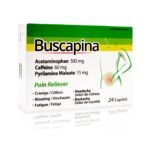What Does Buscapina Hioscina Contain?

Buscapina hioscina is a brand of hyoscine butylbromide, an anticholinergic drug patented in 1950, and approved for medical use in 1951. It is on the World Health Organization’s List of Essential Medicines. It is not available in the United States, and a similar compound methscopolamine may be used instead.
Pharmacological studies have revealed that hyoscine butylbromide is an anticholinergic drug with high affinity for muscarinic receptors located on the smooth-muscle cells of the GI tract. Its anticholinergic action exerts a smooth-muscle relaxing/spasmolytic effect. Blockade of the muscarinic receptors in the GI tract is the basis for its use in the treatment of abdominal pain secondary to cramping. Hyoscine butylbromide also binds to nicotinic receptors, which induces a ganglion-blocking effect.
What are Buscapina hioscina tablets used for?
Buscapina hioscina is used to relieve cramps in the stomach, intestines or bladder. In particular, it helps to ease bloating and the spasm-type pain that can be associated with irritable bowel syndrome and diverticular disease. It works by relaxing some of the muscles in your gastrointestinal and urinary systems.
Buscapina hioscina is available on prescription. You can also buy Buscapina hioscina from a pharmacy, without a prescription, to relieve the symptoms of irritable bowel syndrome, provided your symptoms have previously been diagnosed by a doctor.
Before taking Buscapina hioscina
Some medicines are not suitable for people with certain conditions, and sometimes a medicine may only be used if extra care is taken. For these reasons, before you start taking Buscapina hioscina, it is important that your doctor or pharmacist knows:
• If you are pregnant or breastfeeding.
• If you have prostate problems.
• If you have any other digestive system problems, such as reflux disease, diarrhoea, ulcerative colitis, a blockage in your bowels or severe constipation.
• If you have high blood pressure, or if you have recently had a heart attack.
• If you have glaucoma. This is a condition where the pressure in your eyes is raised.
• If you have been told by a doctor that you have a fast heart rate.
• If you have Down’s syndrome.
• If you are less than 12 years old or over 65 years old.
• If you have been told you have nerve damage, a condition called autonomic neuropathy.
• If you have a condition that causes muscle weakness, called myasthenia gravis.
• If you are taking any other medicines. This includes any medicines you are taking which are available to buy without a prescription, as well as herbal and complementary medicines.
• If you have ever had an allergic reaction to a medicine.
How to take Buscapina hioscina
• Before you start the treatment, read the manufacturer’s printed information leaflet from inside the pack. It will give you more information about Buscapina hioscina and will provide you with a full list of the side-effects which you may experience from taking it.
• Take Buscapina hioscina exactly as your doctor tells you to. It is usual to be prescribed one or two tablets to take three times a day, although your doctor may increase your dose to two tablets four times daily if needed.
• Swallow the tablets with a drink of water. You can take Buscapina hioscina before or after meals.
• If you forget to take a dose, do not take two doses together to make up for the missed dose – just continue with the next dose when it is due.
Getting the most from your treatment
• It is generally recommended that you take Buscapina hioscina only when necessary. So, start taking it when your symptoms flare up and stop taking it when your symptoms settle down again (this is usually within a week or two).
• If you develop any new symptoms, or if your symptoms get worse, make an appointment to see your doctor for further advice.
• If you have bought Buscapina hioscina and your symptoms have not improved within two weeks of taking it, you should see your doctor for advice (even if you have previously been diagnosed by your doctor).
• If you buy any medicines, check with a pharmacist that they are safe to take with Buscapina hioscina . Many medicines that can commonly be bought can increase the risk of side-effects.
Can Buscapina hioscina cause problems?
Along with their useful effects, most medicines can cause unwanted side-effects, although not everyone experiences them. The table below contains some of the ones associated with Buscapina hioscina . You will find a full list in the manufacturer’s information leaflet supplied with your medicine. The unwanted effects often improve as your body adjusts to the new medicine, but speak with your doctor or pharmacist if any of the following continue or become troublesome.
| Buscapina hioscina side-effects (these affect fewer than 1 in 100 people) | What can I do if I experience this? |
| Dry mouth | Try chewing sugar-free gum or sucking sugar-free sweets |
| Dry skin, sweating | If troublesome, ask your doctor for advice |
| Itchy skin rash | Ask your doctor or pharmacist for further advice in case this is an allergic-type reaction |
Buscapina hioscina Safety Information
Tell your doctor of all nonprescription or prescription medication you use, especially of: antidepressants (tricyclic type), MAO Inhibitors (e.g., phenelzine, linezolid, tranylcypromine, isocarboxazid, selegiline, furazolidone), quinidine, amantadine, antihistamines (e.g., diphenhydramine), anticholinergics, potassium chloride supplements, antacids, absorbent-type antidiarrhea medicines (e.g., kaolin-pectin). Do not start or stop any medicine without doctor or pharmacist approval.
If overdose is suspected, contact your local poison control center or emergency room immediately. US residents can call the US national poison hotline at 1-800-222-1222. Canadian residents should call their local poison control center directly. Symptoms of Buscapina hioscina overdose may include unusually dry mouth; excessive thirst; nausea; vomiting; difficulty breathing; blurred vision; dilated pupils; flushed, hot, dry skin; muscle weakness; unusual dizziness or drowsiness; restlessness; disorientation; and seizures.


